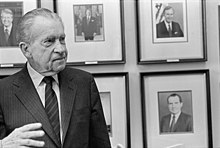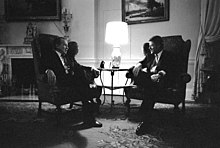User:Informant16/Post-presidency of Richard Nixon
| This is not a Wikipedia article: It is an individual user's work-in-progress page, and may be incomplete and/or unreliable. For guidance on developing this draft, see Wikipedia:So you made a userspace draft. Find sources: Google (books · news · scholar · free images · WP refs) · FENS · JSTOR · TWL |
| ||
|---|---|---|
|
Pre-vice presidency 36th Vice President of the United States Post-vice presidency 37th President of the United States
Judicial appointments
Policies
First term
Second term
Post-presidency Presidential campaigns Vice presidential campaigns
 |
||
Pardon and illness

Following his resignation, the Nixons flew to their home La Casa Pacifica in San Clemente, California.[1] According to his biographer, Aitken, after his resignation, "Nixon was a soul in torment".[2] Congress had funded Nixon's transition costs, including some salary expenses, though reducing the appropriation from $850,000 to $200,000. With some of his staff still with him, Nixon was at his desk by 7 a.m.—with little to do.[2] His former press secretary, Ron Ziegler, sat with him alone for hours each day.[3]
Nixon's resignation had not put an end to the desire among many to see him punished. The Ford White House considered a pardon of Nixon, though it would be unpopular in the country. Nixon, contacted by Ford emissaries, was initially reluctant to accept the pardon, but then agreed to do so. Ford insisted on a statement of contrition, but Nixon felt he had not committed any crimes and should not have to issue such a document. Ford eventually agreed, and on September 8, 1974, he granted Nixon a "full, free, and absolute pardon", which ended any possibility of an indictment. Nixon then released a statement:
I was wrong in not acting more decisively and more forthrightly in dealing with Watergate, particularly when it reached the stage of judicial proceedings and grew from a political scandal into a national tragedy. No words can describe the depth of my regret and pain at the anguish my mistakes over Watergate have caused the nation and the presidency, a nation I so deeply love, and an institution I so greatly respect.[4][5]
In October 1974, Nixon fell ill with
Return to public life
In December 1974, Nixon began planning his comeback despite the considerable ill-will against him in the country. He wrote in his diary, referring to himself and Pat,
So be it. We will see it through. We've had tough times before and we can take the tougher ones that we will have to go through now. That is perhaps what we were made for—to be able to take punishment beyond what anyone in this office has had before particularly after leaving office. This is a test of character and we must not fail the test.[9]

By early 1975, Nixon's health was improving. He maintained an office in a
The interviews helped improve Nixon's financial position—at one point in early 1975 he had only $500 in the bank—as did the sale of his Key Biscayne property to a trust set up by wealthy Nixon friends such as
In 1976, Nixon was disbarred by the New York State Bar Association for obstruction of justice in the Watergate affair. Nixon chose not to present any defense.[19] In early 1978, Nixon went to the United Kingdom. He was shunned by American diplomats and by most ministers of the James Callaghan government. He was welcomed, however, by the Leader of the Opposition, Margaret Thatcher, as well as by former prime ministers Lord Home and Sir Harold Wilson. Two other former prime ministers, Harold Macmillan and Edward Heath declined to meet him. Nixon addressed the Oxford Union regarding Watergate:
Some people say I didn't handle it properly and they're right. I screwed it up. Mea culpa. But let's get on to my achievements. You'll be here in the year 2000 and we'll see how I'm regarded then.[20]
Author and elder statesman

In 1978, Nixon published his memoirs, RN: The Memoirs of Richard Nixon, the first of ten books he was to author in his retirement.[1] The book was a bestseller and attracted a generally positive critical response.[21] Nixon visited the White House in 1979, invited by Carter for the state dinner for Chinese Vice Premier Deng Xiaoping. Carter had not wanted to invite Nixon, but Deng had stated he would visit Nixon in California if the former president was not invited. Nixon had a private meeting with Deng and visited Beijing again in mid-1979.[22]
On August 10, 1979, the Nixons purchased a New York City townhouse at 817

Throughout the 1980s, Nixon maintained an ambitious schedule of speaking engagements and writing,[1] traveled, and met with many foreign leaders, especially those of Third World countries. He joined former Presidents Ford and Carter as representatives of the United States at the funeral of Egyptian President Anwar Sadat.[1] On a trip to the Middle East, Nixon made his views known regarding Saudi Arabia and Libya, which attracted significant U.S. media attention; The Washington Post ran stories on Nixon's "rehabilitation".[28] In a November 1982 interview, Nixon expressed the view that President Reagan should seek out former President Carter's advice in gaining peace in the Middle East, reasoning that Carter knew Prime Minister of Israel Menachem Begin "better than Reagan does."[29]
Nixon visited the Soviet Union in 1986 and on his return sent President Reagan a lengthy memorandum containing foreign policy suggestions and his personal impressions of Mikhail Gorbachev.[1] Following this trip, Nixon was ranked in a Gallup poll as one of the ten most admired men in the world.[30]

In 1986, Nixon addressed a convention of newspaper publishers, impressing his audience with his tour d'horizon of the world.[31] At the time, political pundit Elizabeth Drew wrote, "Even when he was wrong, Nixon still showed that he knew a great deal and had a capacious memory, as well as the capacity to speak with apparent authority, enough to impress people who had little regard for him in earlier times."[31] Newsweek ran a story on "Nixon's comeback" with the headline "He's back".[32]
On July 19, 1990, the Richard Nixon Library and Birthplace in Yorba Linda, California opened as a private institution with the Nixons in attendance. They were joined by a large crowd of people, including Presidents Ford, Reagan, and George H. W. Bush, as well as their wives, Betty, Nancy, and Barbara.[33] In January 1991, the former president founded the Nixon Center (today the Center for the National Interest), a Washington policy think tank and conference center.[34]
In April 1993, Nixon traveled to
Wife's death
Pat Nixon died on June 22, 1993, of emphysema and lung cancer. Her funeral services were held on the grounds of the Richard Nixon Library and Birthplace. Former President Nixon was distraught throughout the interment and delivered a tribute to her inside the library building.[37]
References
- ^ a b c d e f Nixon Library, Post Presidency.
- ^ a b Aitken, p. 529.
- ^ Aitken, pp. 529–530.
- ^ Aitken, p. 532.
- ^ Black, p. 990.
- ^ Aitken, pp. 533–534.
- ^ Black, pp. 994, 999.
- ^ Black, p. 998.
- ^ Aitken, p. 535.
- ^ Ambrose 1991, p. 481.
- ^ Aitken, pp. 537, 539.
- ^ Black, p. 1000.
- ^ Black, p. 1004.
- ^ Drew, p. 138.
- ^ Ambrose 1991, p. 512.
- ^ Aitken, pp. 539–540.
- ^ Black, p. 1005.
- ^ Aitken, p. 543.
- ^ "Nixon disbarred in New York in 1st ruling of Watergate guilt", Toledo Blade, July 9, 1976 p.1
- ^ Aitken, pp. 546–547.
- ^ Ambrose 1991, p. 525.
- ^ Ambrose 1991, pp. 524–525.
- ^ "Nixons Buy Fifth Avenue Condo in N.Y." Pittsburgh Post-Gazette. August 11, 1979.
- ^ Ambrose 1991, p. 528.
- ^ Ambrose 1991, p. 533.
- ^ Ambrose 1991, p. 534.
- ^ Ambrose 1991, p. 540.
- ^ Ambrose 1991, p. 545.
- ^ "NIXON SAYS U.S. CAN USE CARTER'S HELP ON MIDEAST". New York Times. November 14, 1982.
- ^ Drew, p. 142.
- ^ a b Drew, p. 144.
- ^ Aitken, pp. 561–562.
- ^ Aitken, pp. 565–568.
- ^ Black, pp. 1045–1046.
- ^ "Nixon on private visit to China". UPI. April 9, 1993.
- ^ "Former President Nixon meets top Chinese leaders". UPI. April 11, 1993.
- ^ Black, pp. 1049–1050.


